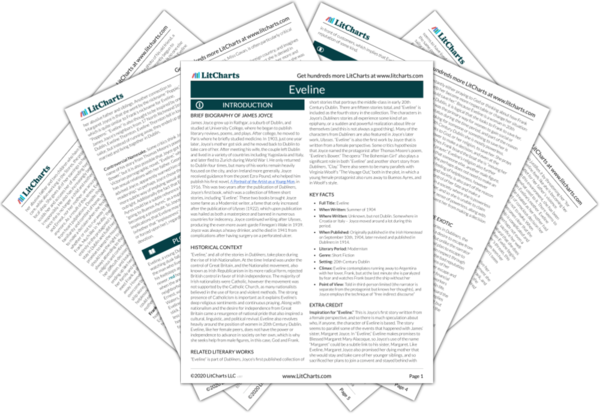Paralysis and Inaction
Joyce’s use of perspective and his characteristic stream-of-consciousness style allow the reader to see Eveline’s thought progression clearly as she contemplates running away to Argentina with her lover, Frank. Eveline’s inability to make a decision, a sort of mental paralysis, results in actual physical paralysis at the end of the story as she stands outside watching Frank board the ship but cannot bring herself to join him. Through her inability to make a…
read analysis of Paralysis and InactionEscapism and the Exotic
As in many of the other stories in Dubliners, the protagonist of “Eveline” has a desire to escape from the drab, brown Dublin life. But unlike the narrator in “Araby,” for example, Eveline has an actual plan to escape to Argentina. She also has an opportunity to gain respect through marriage and also by distancing herself from the bad reputation her family seems to have, escaping the limitations of her current social status. Eveline fantasizes…
read analysis of Escapism and the ExoticWomen and Society
Eveline is the first female protagonist that Joyce introduces in Dubliners, and many of her thoughts and desires are influenced by her role as a woman in 20th Century Dublin. Whether or not she is aware of it, her decisions are greatly affected by outside social forces.
Eveline’s indecisiveness and resulting inaction is largely a result of women’s roles in society at the time. Society has told her she is powerless, and so she…
read analysis of Women and Society
The Many Forms of Death
“Eveline” addresses the subject of death both literally, as when Eveline lists off the people in her life who have died, and figuratively, in several other life events that become metaphors for death. She seems to be very aware of death, and the fact that she has been left behind, either by people dying or leaving.
While Eveline experiences many emotions related to her decision to leave Dublin, she never expresses any strong feelings about…
read analysis of The Many Forms of DeathCatholic Values and Confinement
Joyce clearly illustrates Eveline’s desire for freedom, but in the end she stays behind—partly because of her Catholic background and its religious teachings involving guilt, sacrifice, and promises. Eveline’s appreciation of the Catholic value of sacrifice becomes clear in her duties caring for her family. She seems to sacrifice a great deal of time and effort tending to their needs, and she is living “a hard life.” Eveline sees the sacrifices her mother made…
read analysis of Catholic Values and Confinement











